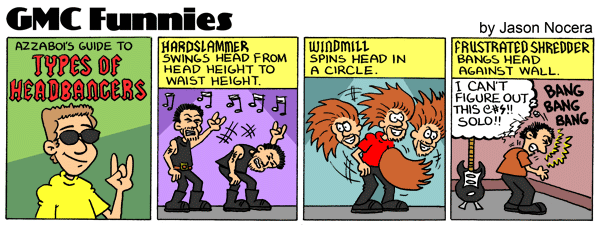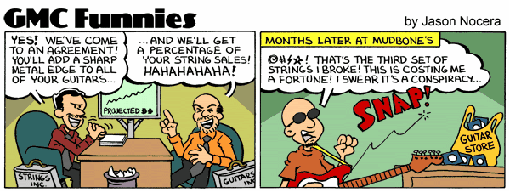Great 80's Thrash Metal Tone, The good old days of cranked Marshall tone |
|
|
|
|
|
| Dec 10 2010, 01:45 AM |
|
"It's time for your medication, Mr. Brown."
Madhouse: The Very Best Of Anthrax is a great album to get, but I never really got into it. It's a bit like Iron Maiden, I like it. However, it sounds a bit weak (being old) compared to the newer soundz. Turn it up and it still doesn't have the "umfffffff" factor like today's stuff. It's still great voice and guitar playing! This post has been edited by Azzaboi: Dec 10 2010, 01:46 AM --------------------  Play Games Arcade Take a break, Play Games! Play the best free online flash games at Aaron's Game Zone like Bloons Tower Defense 4! |
|
|
||
|
|
|
|
| Dec 10 2010, 12:54 PM |
|
.. Old music sounds better turned up really loud, its more dynamic and less compressed than todays production. It seems like music today is produced for use with ipods and the like. In order to get the big bottom end on tiny ear buds the bass needs to be boosted. But when you play the same stuff on a regular stereo system its too bassy and compressed. If you can't get an album produced in the 80's to sound good, you're not turning it up loud enough ... In part. The increase in volume for commercial CDs goes back before I-Pods albeit that it's gotten worse in the last few years. Very few MEs master specifically for I-Pod reproduction, what we do is master to maximise translation across systems. WRT I-Pods often the problem is caused by poor format conversion by the digital re-distributor including compression caused by poor conversion, distortion from intersample overs and not turning off the various options that Apple provide for format shifting a CDA to AAC. What you're describing regarding bass is due to the Fletcher Munson effect, where how well people hear low and very high frequencies in comparison to the high mid is dependent on volume. The ideal production of the full frequency spectrum however does not occur at high volume but at @84dB. Above and below 84dB the low bass and high end actually appear psycho-acoustically to recede in comparison to the high mid. The better, albeit expensive, solution here is to have good full range speakers that are flat all the way down to 20hZ. Most speakers, including home stereos and monitors for mixing however start to roll off from @60 Hz between 3-6 dB per octave. Many start rolling off even as high as 100 Hz. Every 6dB drop is equivalent to halving the volume of that frequency. The end result is that you lose most of the low end because the speakers can't reproduce it accurately. It's possible to add a sub to a speaker system to try and reproduce the low bass. However many subs are not properly integrated with a net result that you do not re-produce the spectrum accurately and you create phase and timing issues along with stereo smearing. Moral of that is if you use a sub set it up properly or you will do more harm than good. Pro-end mastering monitors reproduce accurately to below 40Hz without a sub. However they also cost over 10k dollars. -------------------- Get your music professionally mastered by anl AES registered Mastering Engineer. Contact me for Audio Mastering Services and Advice and visit our website www.miromastering.com
Be friends on facebook with us here. We use professional, mastering grade hardware in our mastering studo. Our hardware includes: Cranesong Avocet II Monitor Controller, Dangerous Music Liasion Insert Hardware Router, ATC SCM Pro Monitors, Lavry Black DA11, Prism Orpheus ADC/DAC, Gyratec Gyraf XIV Parallel Passive Mastering EQ, Great River MAQ 2NV Mastering EQ, Kush Clariphonic Parallel EQ Shelf, Maselec MLA-2 Mastering Compressor, API 2500 Mastering Compressor, Eventide Eclipse Reverb/Echo. |
|
|
||
|
|
|
|
| Dec 11 2010, 01:15 PM |
|
.... But a 6db cut resulting in halving the volume of said instrument...? That stuff blows my mind ! Not quite Ben Again and related to Fletcher- Munson there is also an issue with the volume that you mix at. The curves are flattest at @84dB, if you mix louder or more quietly then the curve becomes more pronounced and you will hear more apparent bass and high frequency. That can lead to you having an inaccurate perspective of the integrity of the mix: if you change the volume the mix starts to fall apart. At mixing the better solution is to mix at 84dB in order to hear the frequency range as accuartely as possible and if necessary check it at a higher and a lower volume. BTW there's a related but different issue with a lot of studio monitors for mixing. Very few are flat across the whole audible frequency spectrum 20Hz to 20kHz. A lot of them will attenuate or add gain at various points, often because they are deliberately designed and tuned to do so. Many are tuned specifically to 'sweeten' up or add 'warmth' to a vocal. People like this because the effect often is to make the sound more 'musical' etc but too often it can lead to mixes that have a high mid that are unbalanced on other playback system i.e. the mix doesn't translate well. One possible solution to this is to use more than one monitoring chain to check translation. However what can and does occur here is that the mix engineer loses confidence in their own ability to make decisions if the mix sounds different on different chains. One of the big parts of the job for a mastering engineer is having the experience and confidence to be able to decide what to do to ensure that a mix translates. To a great extent if you know you're monitoring chain well you can take some of this in to account to an extent whilst mixing. The difficulty remains however if you need some fine tweaking - if you can't hear it you won't even know you need to do it never mind be able to do it. That's why us mastering engineers invest a lot of money in their monitoring chain and room acoustics. It's also a major reason why you should use a mastering engineer if you can for a commercial release rather than try and master yourself. But I would say that -------------------- Get your music professionally mastered by anl AES registered Mastering Engineer. Contact me for Audio Mastering Services and Advice and visit our website www.miromastering.com
Be friends on facebook with us here. We use professional, mastering grade hardware in our mastering studo. Our hardware includes: Cranesong Avocet II Monitor Controller, Dangerous Music Liasion Insert Hardware Router, ATC SCM Pro Monitors, Lavry Black DA11, Prism Orpheus ADC/DAC, Gyratec Gyraf XIV Parallel Passive Mastering EQ, Great River MAQ 2NV Mastering EQ, Kush Clariphonic Parallel EQ Shelf, Maselec MLA-2 Mastering Compressor, API 2500 Mastering Compressor, Eventide Eclipse Reverb/Echo. |
|
|
||
1 User(s) are reading this topic (1 Guests and 0 Anonymous Users)
0 Members:

























